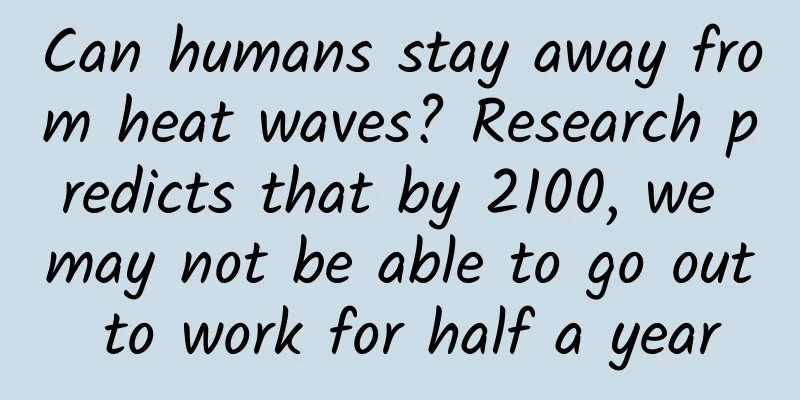Can humans stay away from heat waves? Research predicts that by 2100, we may not be able to go out to work for half a year

|
Recently, a heat wave has swept across China, and "high temperature" and "power rationing" have become hot search keywords on major social platforms. 43.8℃, this is the highest temperature ever recorded in Sichuan Province . Sichuan, a major hydropower province, was once caught in an electricity crisis because of this - some high-energy-consuming enterprises were shut down to maximize the "power for the people". Another natural disaster that accompanies extremely high temperatures is the forest fires caused by drought in many places in Sichuan and Chongqing. When 2022 is labeled as "high temperature" and "drought", and when the world is experiencing the most widespread heat waves and droughts in decades, how should humans reflect? (Source: Pixabay) In fact, as early as 2015, mankind made a commitment to address the global challenge of climate change : to limit the global temperature rise this century to 2 degrees Celsius, while seeking measures to further limit the temperature rise to 1.5 degrees Celsius. This commitment comes from the Paris Agreement, which was adopted by 197 countries at the 21st session of the Conference of the Parties held in Paris. It officially came into force on November 4, 2016. It aims to significantly reduce global greenhouse gas emissions , which is crucial to achieving the Sustainable Development Goals and marks the beginning of the transition to a low-carbon world. Photo: Christiana Figueres, former Executive Director of the Climate Convention, Ban Ki-moon, former UN Secretary-General, Laurent Fabius, former French Foreign Minister and President of the United Nations Climate Change Conference in Paris (COP 21), and François Hollande, former French President, celebrate the historic moment of the adoption of the Paris Agreement. Another well-known commitment is the earlier Kyoto Protocol, whose goal is to "stabilize the content of greenhouse gases in the atmosphere at an appropriate level to ensure smooth adaptation of ecosystems, safe food production and sustainable economic development." However, it turns out that despite mankind’s efforts, there is still a long way to go in curbing global warming. The bad news is that even if the climate goals of the Paris Agreement are achieved, the frequency of global heat waves may continue to increase in the future, a new study shows. Recently, a research team from Harvard University and the University of Washington pointed out that by 2100, tropical regions may be exposed to dangerous high temperature levels most of the time, and mid-latitude regions are expected to experience deadly heat waves every year. The results show that even if global warming is controlled within 2°C in accordance with the Paris Agreement, carbon dioxide emissions caused by human activities may still increase the frequency of global extreme temperatures in the next few decades. That is, by 2100, "hazardous" and "extremely hazardous" heat stress will become more common. Heat stress is the sum of a series of nonspecific systemic responses, including perceptible discomfort and physiological fatigue, when humans or animals are exposed to a hot environment, especially when accompanied by physical activity. The related research paper, titled “Probabilistic projections of increased heat stress driven by climate change”, has been published in the Nature subsidiary journal Communications Earth & Environment. (Source: Communications Earth & Environment) A string of deadly heat waves has hit many major cities over the past decade. If greenhouse gas emissions are not reduced, the impact of climate change on heat waves will threaten the habitability of much of the planet. Extreme heat is a threat to public health, with extreme heat causing heat cramps, heat exhaustion and chronic illnesses. To predict the average changes in global temperature, carbon dioxide concentration, and relative humidity, the paper's first author, corresponding author, Harvard University postdoctoral researcher Lucas Vargas Zeppetello and his collaborators analyzed global climate model projections, population forecasts, and the relationship between economic growth and carbon emission intensity. The statistical approach "gives plausible ranges for carbon emissions and future temperatures, statistically estimated and validated against historical data," said co-author Adrian Raftery, a professor of statistics and sociology at the University of Washington. The results show that the probability of achieving the latest goal of the Paris Agreement - limiting the global average temperature rise to 1.5 degrees Celsius by 2100 - is only 0.1% , and the global average temperature change is likely to be close to 2 degrees Celsius by 2050. (Source: Pixabay) In addition, they introduced the concept of the "Heat Index." "These standards were originally developed for people working indoors in boiler rooms and so on, and no one thought that such high temperatures would occur in outdoor environments. But now we see it," Zeppetello said. The heat index is a thermal index that combines air temperature and relative humidity. The National Weather Service defines a "dangerous" heat index of 103 degrees Fahrenheit/°F (39.4 degrees Celsius); an "extremely dangerous" heat index of 124 degrees Fahrenheit/°F (51 degrees Celsius), which is considered unsafe for humans at any time. They found that even if the world works to meet the Paris Agreement goal of limiting global warming to 2 degrees Celsius, by 2100, the number of days exceeding the "dangerous" heat index in the United States, Western Europe, China and Japan will be 3-10 times higher than it is now. Under the same scenario, by 2100, the number of "dangerous" heat days in tropical regions could double and last for half a year. They project that in a worst-case scenario, in which greenhouse gas emissions are not effectively curbed until 2100, many people living in tropical regions, such as India and sub-Saharan Africa, would be exposed to dangerously high temperatures for much of a typical year. Moreover, deadly heat waves that are currently rare in the mid-latitudes could become an annual occurrence there - a region between the two tropical regions and the Arctic Circle. For example, the probability of a dangerous heat wave in Chicago, USA, would be 16 times higher. (Source: Pixabay) “Recent record-breaking summer heat events will become more common in places like North America and Europe,” Zeppetello said. “For many populations living near the equator, it will be difficult to work outdoors more than half the year by 2100, even if humans start to curb greenhouse gas emissions.” In addition, the research team pointed out that if no adaptation measures are taken, the incidence of heat-related diseases may also increase significantly, especially among the elderly, outdoor workers and low-income groups, and it is necessary to establish stricter emission reduction targets. “Our study shows a wide range of possible scenarios for the year 2100,” he said. “This suggests that the greenhouse gas emissions choices we make now remain important for creating a livable future.” “ It’s scary to think what would happen if we had 30 to 40 days a year that exceeded the ‘extremely dangerous’ heat index threshold, ” Vargas Zeppetello said. “While these are scary scenarios, we have the ability to prevent them.” Reference Links: https://www.eurekalert.org/news-releases/962517 https://www.nature.com/articles/s43247-022-00524-4 |
<<: Why are all the mountains in the world no higher than 10,000 meters?
Recommend
Overseas listings: Differences in audit systems between China and the United States pose risks
The golden age of Chinese stocks listed in the US...
How to help Socrates find the most beautiful flower?
Once upon a time, there was a story that told the...
"Refined" community operation routine
Bad communities are all the same; good communitie...
The entire process of live streaming with goods on Douyin!
In addition to the popularity of short videos, li...
From 0 to 1, the secret of starting new media operations
Nowadays, both Internet companies and traditional...
Advanced Operations | A new way to control traffic, with 4 cases, 10,000-word collector's edition
As we all know, traffic is a matter of life and d...
What should you do when faced with malicious clicks on your website through paid bidding by your competitors?
The way to deal with malicious clicks is very sim...
Feel and create the future. No technology without GAC. GAC 2020 Technology Day has a major announcement
On July 28, GAC TECH DAY 2020 with the theme of &...
In addition to Jobs, what changes have Apple's press conferences undergone over the years?
At Apple's press conference this time, Apple ...
Who helps us do experiments in space? Decoding the scientific glove box
The successful launch of the Wentian experimental...
Shandong, “half of it is on the sea”!
What color do you think of when you mention Shand...
Television stations that rely only on traditional channels are doomed to fail
The topic "Five reasons why you won't wa...
In the US presidential election, how do social media platforms show their power?
In the end, Trump won the US presidential electio...
Apple's iOS system was exposed to frequently obtain user privacy
As the price of Apple phones continues to drop, c...
User fission strategy: 10 methods of “using old customers to bring in new customers”!
Advertising traffic is too expensive? SEM prices ...









